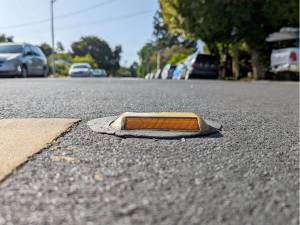
Road studs have many names, cat’s eyes, retro-reflective road studs, or raised pavement markers, and they are crucial for road safety
They provide essential guidance to drivers in poor weather or low-light conditions by reflecting light from headlights, helping maintain lane discipline and reducing accident risks.
Preparation
Successful road stud installation relies on careful preparation, as proper planning and execution can prevent issues and ensure long-lasting effectiveness.
Site Survey and Planning
Begin with an installation site site survey to assess the road layout, traffic flow, and unique features such as curves and intersections.
This understanding will inform the strategic placement of road studs for optimal visibility and guidance, while also considering the best type of road stud for the conditions.
Safety Precautions and Traffic Management
Safety is the top priority during installation. Implement measures like traffic cones, barriers, and warning signs to protect the crew and public. Redirect traffic if needed and ensure all crew members wear proper safety gear, including high-visibility vests, helmets, and gloves.
Tools and Equipment Required
Before starting the installation, gather all necessary tools and equipment, including road stud markers, drills, adhesives, mechanical fixings, cleaning supplies, and safety gear. This preparation helps avoid delays and ensures a smooth installation process.
Surface Preparation
Proper surface preparation is essential for the successful installation of road studs, ensuring they adhere correctly and stay in place over time.
Cleaning and Marking the Installation Area
The first step in surface preparation is to thoroughly clean the road surface using appropriate tools to remove contaminants that could affect adhesion. After cleaning, accurately mark the installation position for the road studs to ensure optimal visibility and effectiveness.
Ensuring the Surface is Dry and Free of Debris
After cleaning, make sure the surface is completely dry to ensure effective adhesion of road studs. Moisture can lead to poor attachment, so remove any remaining debris that may disrupt installation.
Temperature and Weather Considerations
Weather conditions play a vital role in the installation process. Opt for moderate temperatures and avoid extreme weather, as hot or cold conditions can affect adhesive curing.
Similarly, refrain from installing road studs in rainy or humid weather to prevent moisture from compromising adhesion and reducing service life.
Installation Process
Road stud installation methods differ based on stud type and site requirements, and understanding these methods is crucial for ensuring proper and secure installation.
Adhesive Installation
A common method for installing road studs involves using a strong adhesive like epoxy glue on the stud’s base and pressing it firmly onto the prepared road surface with proper spacing.
This technique is effective for plastic, ceramic, and aluminium studs, ensuring a secure bond that endures traffic and environmental conditions.
Mechanical Fixing
Mechanical fixing is essential for road studs in high-traffic areas, involving drilling holes and securing studs with screws or bolts for added security.
This method is particularly useful for aluminium road studs or on uneven road surfaces to ensure they stay in place despite heavy use.
Maintenance and Inspection
Regular maintenance and inspection of road studs are crucial for ensuring their effectiveness and safety, as neglect can lead to reduced visibility and heightened risks for road users.
Regular Inspection Routines
Establish a routine for regular inspections of road studs to check for wear, damage, or loosening. This proactive approach helps identify issues early and enables timely maintenance.
Signs of Wear and When to Replace Road Studs
Road studs wear out over time due to traffic, weather, and general use. Common signs of wear include fading reflectivity, cracking, and damage. It’s important to replace any damaged studs promptly to ensure road safety.
Common Issues and Troubleshooting Tips
Monitor road studs for issues like adhesive failure, too much glue, misalignment, or damage from heavy vehicles. Address these problems promptly to prevent accidents and maintain their functionality, which may involve reapplying adhesive or tightening fixings.
Buy Road Studs in Malaysia

Investing in a high-quality reflective road stud is crucial for road safety. When choosing road studs, prioritise durability, visibility, and ease of installation.
Asia Warehouse is a leading supplier of high-quality road studs in Malaysia, dedicated to enhancing road safety and visibility for all users. Our durable road studs are designed for high-traffic areas and come in various types suitable for different environments.
